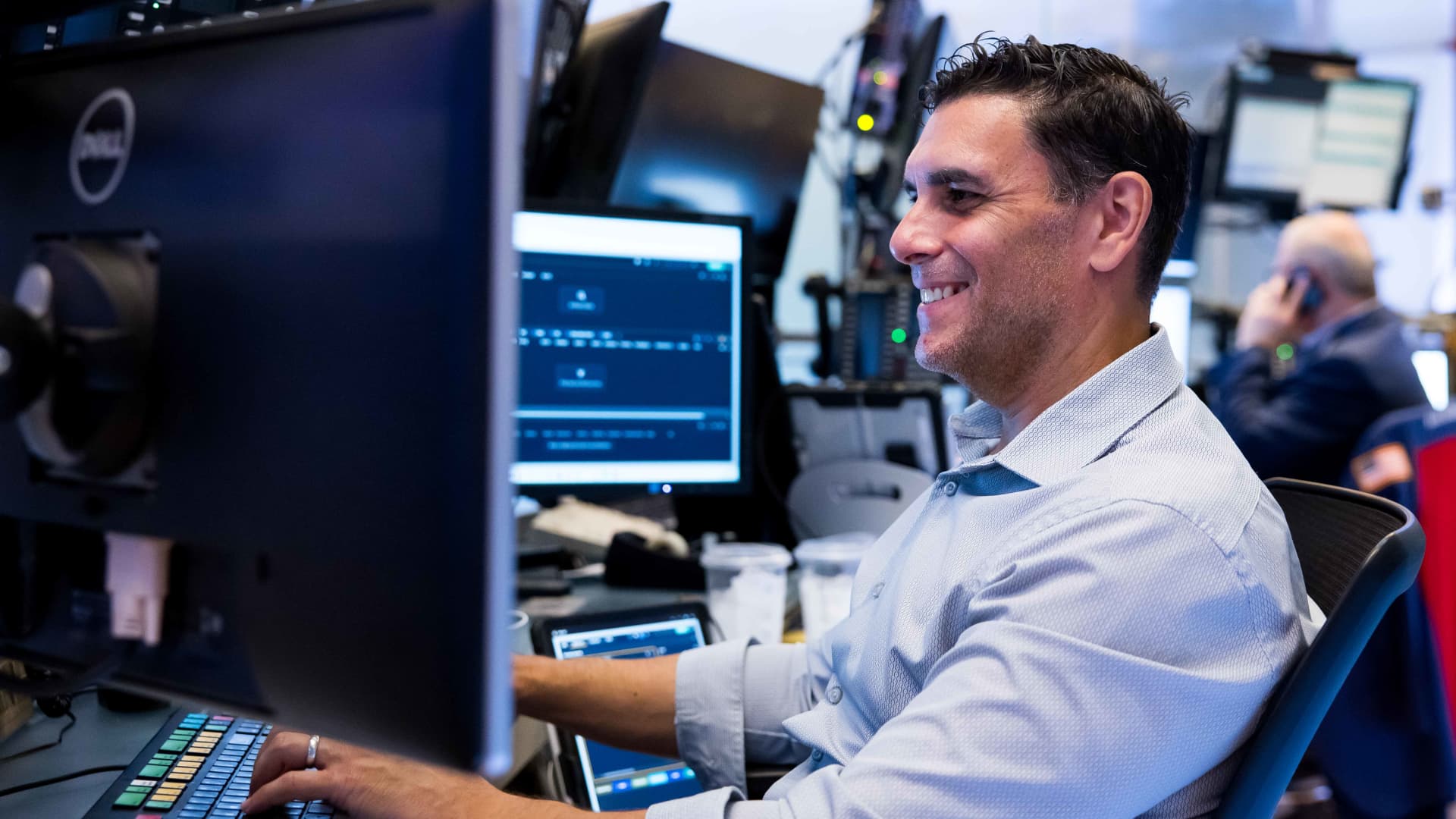When the tyranny of the “Magnificent Seven” ended, I always figured the money would go to the rest of tech. I also didn’t think that there would be anything left of the Mag 7 to invest in. They would all be obliterated as part of a source-of-funds move. Club name Nvidia would be grounded by China fears, both DeepSeek and restrictions by President Donald Trump. It was too good to be true, when Nvidia was in the high $80s a share, that it could find its way to new highs. Microsoft , another portfolio member, would falter because Copilot would falter. How in heck could Microsoft’s stock retain its leadership thanks to Azure growth picking up by just a few percentage point? The answer to this conundrum is something I have started to come to terms with that calls into question the entire world of stock picking: I am beginning to think the nature of buying the right stocks has shifted from some hedge-fund playbook to a retail-majority fascination that is disrupting everything coupled with a level of hopefulness about individual stocks not seen in ages. I think that much of it stems from a belief that Trump, like him or not, may turn out to be fabulous for the stock market because he is putting in regulators that are pro-business and against a fundamental belief that business itself of any size — including small business — is evil. I know this view cuts across a variety of lines, but it is based on the charts themselves, a comprehensive examination of more than a thousand charts to understand this incredibly complex market. So let’s break it down by pattern and see if my view can hold up to scrutiny. First, the clear winner in this market, bar none, is the financials. That covers insurers. It includes regional banks. But it really involves the majors, including the likes of JPMorgan , Goldman Sachs , Morgan Stanley , Wells Fargo and Citigroup , as well as names like asset management giant BlackRock , which is newly anointed after struggling for some time. We own Goldman, Wells and BlackRock for the Club. I can’t emphasize enough how important this move financials is. It encompasses a multitude of thoughts, a cornucopia of positives the likes of which we haven’t seen in ages, and they revolve around what could be an extended trend involving multiple expansion from the current range of roughly 14 to 15 times earnings to something closer to the market’s 22 multiple. How is that possible? A few reasons: We are beginning to believe that deep in the heart of the Biden administration was a core group of administrators in the agencies who were from the Bernie Sanders/Alexandria Ocasio-Cortez wing of the party. That’s the part of the party that many traditional Democrats feel has hijacked the apparatus and may have been responsible for some of the backlash that led to the disaffection of typical middle-of-the-road bankers who might have been enthusiastic Democratic supporters but went for Trump or didn’t vote at all. Those agency administrators — including those in the Federal Trade Commission and the Justice Department, but also the Federal Communications Commission and Federal Energy Regulatory Commission and all of the others that interfaced with businesses — simply had a dislike for Corporate America that mimicked that of former President Joe Biden. As someone who followed Biden’s career and knew him fairly well at one point, I was shocked how anti-business he had become. The core group who ran the country in the last two years may have been as antithetical to the positives of business as any that our history has recorded, maybe even in the first years of Franklin D. Roosevelt administration, maybe worse. The insult to business found its leader in former FTC chief Lina Khan, a 36-year-old populist firebrand who was an anathema to business and tried to check its every move. She reminded me of a modern-day Mary Lease. But she was almost outdone by the Consumer Financial Protection Bureau which, at its core, despised the banks it regulated and truly viewed them as the oil behind the kleptocratic machine that drove an ever-widening wedge between the rich and the poor. Without the incredibly fast dismantling of what amounted to a nihilist fifth column within the government, we are seeing nothing more than a wholesale revision of a group of stocks that has been shackled ever since the 2008 financial crisis when the multiples were far higher than they are now. With the anti-business wing of the Democrats now crushed, we are left with a nexus of banks that will be able to print money the following ways: Facilitating a merger wave that will be among the most powerful in history after it had been on hold because of Khan’s strident policies. Mergers and acquisitions involves a small handful of people at these banks so their profit margins will be immense. A more forgiving “stress test” from the Federal Reserve with an easy curve that will allow much more money to be put to work lending. We just saw the beginnings of this Friday evening , and more reform could be on the way. An initial public offering market that will be intense, and I expect many private equity-owned companies that have been kept on those firms’ balance sheets will be offloaded on the public. A wave of foreign buyers because of a weak dollar, a la the period between 1987 to 1989. A dramatic shift of disrupters who will IPO even as they pretended they did not want to. They can’t help themselves. There’s too much stock-based compensation for younger employees to stay private. A dramatic cost reduction accomplished by cutting the number of younger associates who specialized in meeting ever-increasing regulations and documentation who did nothing but repeat the same document writing over and over. Now that can be done by artificial intelligence. This new regime can last a couple of years and, on net, will produce equity shrinkage before the secondary offerings overwhelm the market. It is breathtaking in its power because it is producing stock-chart breakouts the likes of which I have never seen before. That includes credit card issuers like Club name Capital One and American Express , along with the money centers and investment banks. Second set of winners: the data centers and all of its accoutrements. This move is tectonic in nature because we have never seen an industrial revolution like this before. Some want to compare it to the internet bubble. I view it as a space race among a host of companies that must spend money to stay in the new game of generative AI, which can change the way we do everything from banking and self-driving to robots and the construction of buildings and ships. That’s Meta Platforms , Amazon , Alphabet , Microsoft, Oracle and Tesla for those who are counting. We own Meta, Amazon and Microsoft for the Club. At the heart of this technological revolution is the physical data center itself. It’s based around semiconductors, not software, and that’s a huge change. If you look at the software companies, especially enterprise software, you see stalled stocks like ServiceNow , Workday , MongoDB , Salesforce , Accenture and Adobe . These are truly struggling stocks this year that now feel like they are all going against each other. There are some surprising names on that list. Contrast those charts with the performance of names like Club name Eaton , Carrier , Johnson Controls and Emerson Electric for the grid; or GE Vernova , Quanta Services and really anything involving natural gas or nuclear power; or CoreWeave and Nebius , as well as Vertiv , Cummins and Arm Holdings . These moves are insanely powerful. The money coming out of enterprise software is making a beeline to the much smaller semi cohort like Analog Devices , KLA Corp , Lam Research , Texas instruments , Advanced Micro Devices and Micron . The amount of money coming into the exchange-traded funds that agglomerate these segments is spectacular. Oh, and let me say it again for emphasis: Nvidia. There is a small and puzzling group of contract manufacturers — Flex , Celestica and Jabil — with stock moves that defy logic. I don’t have a line on it yet, but it is a fascinating move. And then there are the companies that have figured out how to minimize their tariffs and are ready to roll come July 9, the day that Trump’s 90-day pause is set to expire. Then there are the losers, and they are so hideous I wouldn’t even deign to think of them as a possibility in a fund: drugs, foods, consumer packaged goods, retailers save the dollar stores, fast food (as opposed to fast casual), and oil and gas. These are plain out sources of funds and can’t be trusted to hold no matter how big their yields might become. Take a look at Conagra and Campbell’s if you disagree. What’s it all mean? This is a market where the discourse is radically at odds with what we talk about all day. We are so stuck on Fed talk — should they cut? — that we are part of the hideous misdirection play that is going on in the professional discourse of the moment. These buyers and the stocks they buy don’t care about any of what “we” talk about, and I have to redouble my efforts to try to blunt what I see as a radical mistake in coverage that is geared toward hedge funds and not the dominant chord of individual investors. Oh and remember, I am not even talking about the youthful traders who congregate around stocks like Coinbase , Robinhood and Michael Saylor’s bitcoin-focused Strategy . While that cohort can’t be ignored, they are more obvious. They are part of a confused, momentum-oriented new investor class that is led by those who will drive Palantir to $200 a share, an excellent speculative stock by the way. And it is going to $200. Now, I am schooled in the value of the Fed talk myself. But I am trying to pull the wires from my own brainwashing, which is never easy. I need to go back to the 1990s, when what mattered was stock picking — not the S & P 500 and earnings; not sales and companies that did something meaningful; not companies that catered to the enterprise software mob of code-writers who might be obviated by AI; or those who do nothing but trade the S & P and a bunch of stupid ETFs. Will it be difficult to upend the Fed-geared reportage that every single outlet finds to be the holy grail of business journalism? No. Because those who follow it and believe in it don’t know jack about individual stocks anyway. Learning about them is a time-consuming anathema. Plus, they don’t know their game is atavistic anyway. They don’t see themselves as an obstacle to new world performance. Business journalism has gotten away from learning new stories — too difficult and time consuming and not the province of young researchers anyway. They console themselves that they follow Magnificent Seven drizzle and can speak about Tesla with the best of them. In order to help the waning tide of viewers to stay with us, the new manifesto is to learn the “great unwashed” of stock stories that are under $100 billion in market cap that are truly terrific. There are investors who want to own Nvidia or the next Nvidia, and by golly, we better help find them, or we might as well cut the cord, too. (See here for a full list of the stocks in Jim Cramer’s Charitable Trust.) As a subscriber to the CNBC Investing Club with Jim Cramer, you will receive a trade alert before Jim makes a trade. Jim waits 45 minutes after sending a trade alert before buying or selling a stock in his charitable trust’s portfolio. If Jim has talked about a stock on CNBC TV, he waits 72 hours after issuing the trade alert before executing the trade. THE ABOVE INVESTING CLUB INFORMATION IS SUBJECT TO OUR TERMS AND CONDITIONS AND PRIVACY POLICY , TOGETHER WITH OUR DISCLAIMER . NO FIDUCIARY OBLIGATION OR DUTY EXISTS, OR IS CREATED, BY VIRTUE OF YOUR RECEIPT OF ANY INFORMATION PROVIDED IN CONNECTION WITH THE INVESTING CLUB. NO SPECIFIC OUTCOME OR PROFIT IS GUARANTEED.
Hopeful stock market is delivering some surprising winners










